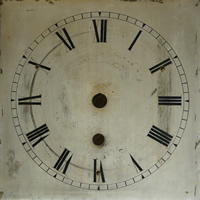Jude’s clock
A fine Library Clock

This is an intriguing little clock. It has an excellent, heavily plated, fusee movement that I guess is mid-Victorian and of English manufacture although there is no identification. It has a fine etched/engraved and silvered dial again with no identification. The case is plain and made of oak and the movement is attached to the case by a two brackets and bolts through the sides of the case (see pictures). Also interestingly there is a pendulum transit locking device (a locking bridge) visible through a glass in the rear door panel.
This clock is fairly typical of a library clock although those that come on the market generally have more ornate casework but still of fairly simple design. In good condition they fetch very high prices!
The ‘repair’.
On first inspection there seemed very little wrong with it. A bit dirty and someone had oiled the gears fairly liberally (the gears should actually run dry and only the pivots oiled). A wind on the key and it ticked away happily. I decided to give it a good clean so stripped it down.
On removing the face - horror - there was no minute wheel cock! How on earth could that get misplaced, it is just not possible? (Did I have a “senior moment” remove the minute cock and then hide it from myself in some obscure place then totally forget – scary!)
Anyway, after cleaning and reassembly I made a new cock. The face was dirty and scratched and I cleaned it and touched up the silvering where it has worn away. There were no other particular issues. The winding ‘click’, within the fusee, showed signs of damage rather than just wear but it was still serviceable and would be a nightmare to repair/replace. I put a couple of new feet on the case that were missing.
Here are some pictures. Click on the thumbnails for close-ups or click on the main picture above for a close up of the clock itself.
5th July 2016





